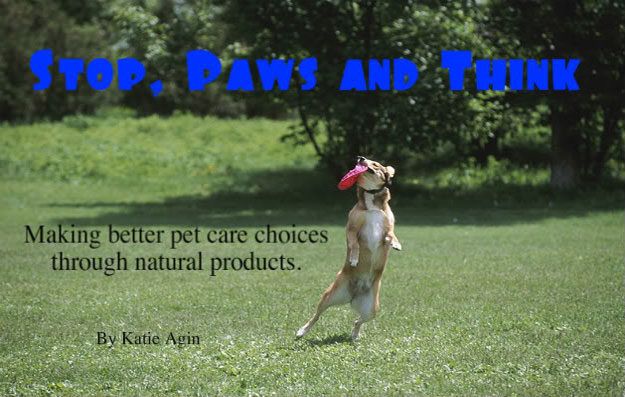Thousands of years ago, dogs were domesticated by humans, and they have faithfully trotted by our sides ever since. Similarly, cats have rid our homes of rodents and provided us with the comfort of a purr for almost as long. In fact, pets of all kinds have brought joy to humans for ages. Thankfully, the pet care industry, retailers and consumers are making the effort to repay the favor.
With better pet care, comes longer life for pets. However, Stephanie Johnson, pet division brand manager at American BioSciences, Inc., Blauvelt, NY, notes, “Living longer doesn’t always mean a longer ‘quality’ of life—owners need to adjust foods, activity, supplements and so on to meet the changing needs of an aging pet.” With emerging improved formulations and innovative products for pets, owners can do just that. According to Packaged Facts, “New products continue to flood the market, which saw more entries in 2008 than in any previous year” (1). Heightened safety concerns have molded product development and marketing, as well as directed the decisions of pet owners looking for the best products possible.
History Repeat Itself? Not if We Can Help It
The 2007 melamine catastrophe was predicted to leave the pet food market in shambles, but the industry has proven to be resilient. According to Packaged Facts, “The spring 2007 recalls actually boosted sales a bit, by causing consumers to convert to higher-priced priced foods perceived to be safer, a trend felt in both mass-market and pet specialty channels” (1).
Although the melamine scare triggered shoppers to reevaluate and revamp their pet product buying habits, many consumers are unsure of where to start when it comes to making positive changes in their pets’ care. Marci Clow, MS, RD, senior director of product research and Tom O’Leary, a K9 Health Advocate for Rainbow Light Nutritional Systems, Santa Cruz, CA, emphasize, “Choices in natural pet care depend on the objectives, lifestyle and dietary habits of the pet.”
One trend showing continuous growth is that human-grade pet foods and supplements are becoming the standard for consumers. Pets are thought of as members of the family who deserve products made with the very best ingredients. Jean Hofve, Advisory Board Member for Nordic Naturals, Watsonville, CA, forecasts increased “humanization” of pet food, meaning those that mimic human products. Bob Terry, technical services director for Green Foods Corporation, Oxnard, CA, agrees,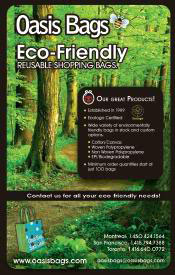 stating, “As people become more aware of the value of organic and natural food and supplements for themselves they naturally want their pet products to be of the same high quality. He also observes how pet owners are also “demanding to know the country of origin of both the product and the raw materials in the product.”
stating, “As people become more aware of the value of organic and natural food and supplements for themselves they naturally want their pet products to be of the same high quality. He also observes how pet owners are also “demanding to know the country of origin of both the product and the raw materials in the product.”
Also, pet care is now reflective of growing trends in human foods and products. For example, foods with functional aspects also continue to flourish, especially those targeting age- and weight-related conditions, and those including ingredients like glucosamine, omega fatty acids, antioxidants and probiotics (1).
“The growth of omega-3 products for humans propelled research on their use for animals, and we now see the effective use of omega-3s in canine wellness supplements. Additionally, growth trends in digestive products containing probiotics seem to have branched over into products for pets,” say Clow and O’Leary.
Take care when explaining pet supplements to customers. Susan Weiss, president of Ark Naturals Products for Pets, Naples, FL, warns, “Many humans think they can substitute human supplements for pet use. Many times formulas and dosages are not translatable from humans to pets.”
Time to Chow Down
Food is an area where pets’ and human desires are alike: we want great flavor and nutrition, even if our tastes might vary. Weiss states, “There is no such thing as a universal diet. Just as in humans, variety is key, high-end ingredients are key, and making sure that particular diet is safe and effective for the pet.” Hofve agrees, noting that animals typically develop allergies or intolerances when kept on the same diet for years on end and recommends periodically switching flavors and brands.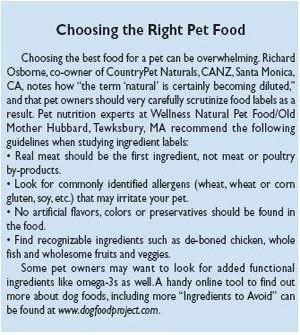
Green Foods. It’s a common misconception that cats and dogs are purely carnivorous. In reality, it is normal for them to eat greens. Terry says, “Cats and dogs don’t get enough green foods, particularly grasses. While mature grasses can be irritating to the digestive tract, grass sprouts and grass juice powders are non-irritating and are easily consumed and digested.” Products such as Barley Cat and Barley Dog from Green Foods Corp. can easily be sprinkled on pets’ food to increase their intake of greens. Barley grass, says Terry, can improve skin and coat health and energy levels from its wide array of vitamins, minerals, amino acids and proteins. The chlorophyll contained within green foods can also help freshen breath.
Raw diets. Raw diets have been increasing in popularity, with mixed feelings from experts on the subject. Terry explains, “The food animals consume in the wild is raw so it is good to include as much raw foods in the diet as possible. Raw foods contain more nutrients and natural enzymes than cooked and processed food and therefore, contain greater nutrition and are more readily digested.”
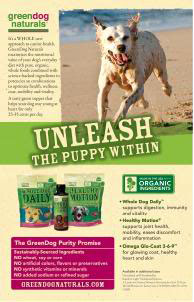 On the other hand, Richard Osborne, co-owner of CountryPet Naturals, CANZ, Santa Monica, CA, notes two common problems with a raw diet. “Dogs love and thrive on more meat and many raw diets are really just filling out their meals with large percentages of cheaper ingredients such as potatoes. The key is providing more real meat,” he says. Osborne also points out the risk for pets’ families by constantly handling raw meat which must be left out for a pet to
On the other hand, Richard Osborne, co-owner of CountryPet Naturals, CANZ, Santa Monica, CA, notes two common problems with a raw diet. “Dogs love and thrive on more meat and many raw diets are really just filling out their meals with large percentages of cheaper ingredients such as potatoes. The key is providing more real meat,” he says. Osborne also points out the risk for pets’ families by constantly handling raw meat which must be left out for a pet to
eat. “Extra care is required to prevent salmonella and E. coli issues for the consumer,” he adds.
Because of the natural bacteria found in raw diets, many pets might have some digestive troubles as a result. Weiss, of Ark Naturals, recommends that pet guardians should supplement with a probiotic such as Ark Naturals’ Gentle Digest and an antioxidant such as Canine Chewable Wafer or Granular Greens.
Overweight pets. Portly pets might elicit a few more “aww’s” from admirers, but they also have an increased risk of developing cardiovascular diseases, osteoarthritis, diabetes, weakened immunity, decreased energy and so on. Edward Moser, consulting veterinary nutritionist for Wellness Brand Premium Pet Food, Old Mother Hubbard, Tewksbury, MA, confirms that pets’ conditions can be carried down to their puppies or kittens. Not so cute, after all.
In a 2007 study referenced by Moser, the University of Illinois at Urbana Champaign found 25–40% of dogs and cats to be overweight. Terry notes, “Like people, pets become overweight when fed a diet high in sugar, high-glycemic carbohydrates, trans fats and saturated fats, so it is best to reduce these and increase their intake of protein and raw vegetables, especially greens, and some fruits, including berries.”
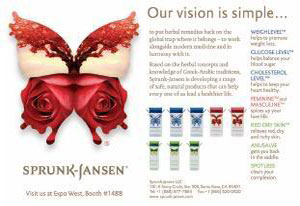 Donna Spector, consulting veterinarian for Halo Purely for Pets, Tampa, FL, adds, “Corn and rice contribute to obesity because they are carbohydrates with a high-glycemic index. This means they raise blood sugar levels rapidly and create hormonal signals that have negative long-term affects on metabolism and weight gain.”
Donna Spector, consulting veterinarian for Halo Purely for Pets, Tampa, FL, adds, “Corn and rice contribute to obesity because they are carbohydrates with a high-glycemic index. This means they raise blood sugar levels rapidly and create hormonal signals that have negative long-term affects on metabolism and weight gain.”
Most experts agree that in addition to a dietary overhaul, increased activity will help pets reach their ideal weight.
Fetch Some Bone And Joint Formulas
For some pets, especially those who are aging, movement and exercise can become quite painful due to bone and joint deterioration. The most common types of arthritic problems in dogs, cats and horses alike are hip and/or elbow dysplasia, osteoarthritis and soft tissue and joint disruption from a stress injury (2). There are numerous nutrients said to help pets with bone and joint health, some of which include (2):
• Glucosamine has been shown to improve symptoms of arthritis and assist in the regeneration of joint cartilage.
• Chondroitin is similar to glucosamine, with a common anti-inflammatory effect.
• Hydrolyzed collagen (type II collagen) from bovine, shark or chicken is helpful with arthritis by mechanisms of immune tolerance to address issues like rheumatoid arthritis and connective tissue disease.
• Bromelain is an enzyme that helps with soft tissue injury and inflammation.
• Methylsulphonylmethane (MSM) is a sulfur with natural anti-inflammatory action.
• Boswellia serrata is a natural anti-inflammatory similar to conventional NSAIDs (non-steroidal anti-inflammatory drugs), but without significant gastrointestinal side effects.
• Calcium and phosphorus in a 2:1 ratio make an ideally balanced and bioavailable supplement for bones to help prevent osteoarthritis.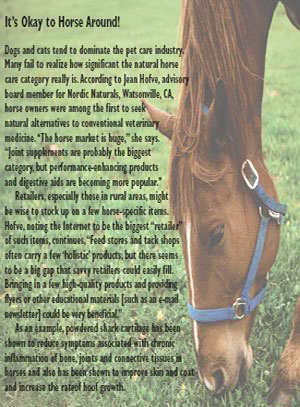
These natural remedies tend to take a bit longer than drugs from conventional veterinary practice to become effective, but will have fewer side effects and will be more effective in preventative and long-term care. “The success of glucosamine and chondroitin products in supporting joint health is one clear example of the potential for nutritional supplements to diminish the likelihood of a chronic health issue that can be very painful for the dog and extremely costly for a dog guardian,” say Clow and O’Leary.
Johnson adds that American BioSciences’ DGP addresses many of the health needs of older dogs, and dogs with breed-specific or injury-related mobility problems by relieving pain and inflammation.
Other ways are to soothe aching muscles, bones and joints through the topical use of essential oils and massage.Sit.
Stay. Supplement…Please?
Successfully giving a supplement to a pet can be difficult and upsetting for owner and pet. Pets are often confused and fight to escape; the owner will be frustrated, pity the pet and end up cleaning an unwanted mess. Luckily, the days of “pill-shoving” and scratched arms are over as many supplements are available in pet- and people-friendly delivery forms.
“Powders and oils are great because they can easily be mixed into a dog’s food without the dog even knowing it and, in some cases, they can improve the taste of the food,” say Clow and O’Leary.
For pets that need another option, Hofve thinks, “’Pill pockets’ and other malleable treats that can be wrapped around tablets and capsules are great. Supplements that themselves taste good, or at least are palatable enough to be disguised in food, make life easier for people,” and pets, for that matter. “Cats, however, remain a challenge!” she adds. For finicky felines, liquid supplements that can be delivered directly with a dropper might make the process easier and faster.
Down and Dirty with Pet Hygiene
Every owner wants their pet to be clean, comfortable and happy—and have their household remain that way too. Kelly Vlahakis, vice president of media relations at Earth Friendly Natural Products, Winnetka, IL, recommends products that are made with “replenishable, plant-based ingredients and naturally occurring enzymes that do not leave behind any toxic residue” when it comes to all aspects of a pet’s health and environment.
Skin/Coat. The health of our four-legged friends can be reflected in the health of their skin and coat. According to Weiss, “90% of the time, skin and coat issues are nutritional issues. Topicals help skin issues on a temporary basis, but you need to think of the problem from the inside out.” Skin and coat can also be vastly improved through supplementation. For example, Clow and O’Leary state, “The ability to influence the health of skin and coat by supplementation of omega fatty acids is another clear example of a cost-effective way to deal with common nutritional issues.”
Hofve of Nordic Naturals agrees, saying, “The number one supplement for skin and coat health is essential fatty acids.” Omega-6s can help pets with dandruff, she continues, but “what pets really need are omega-3s to balance high levels of omegas-6s in the diet and provide soothing, anti-inflammatory power.”
When it comes to addressing pets’ dermatological dilemmas topically, Autumn Blum, formulator and CEO for Organix-South, Inc., Bowling Green, FL, says, “Just like people, many dogs are allergic to seemingly benign ingredients. For example, you may not want to give a gluten-intolerant dog a shampoo with hydrolyzed wheat protein.” She notes many natural ingredients that can be safely used to support pets’ skin including neem, aloe and calendula. She continues, “Neem has been used for thousands of years to relieve itching from bites, calm reactions to environmental stresses, soothe chronic skin irritation and promote a healthy response to minor inflammation.”
Dental. With the thought of pet tooth brushing, most owners will roll their eyes, give a hearty, “Yeah, right,” and envision knocked over lamps and a high-speed chase. But Spector believes there is no substitute to brushing. She says, “Periodontal disease strikes early in pets and is one of the most serious pet health problems, often resulting in tooth and gum infections, pain, loss of teeth and even organ damage. It affects approximately 80% of dogs and 70% 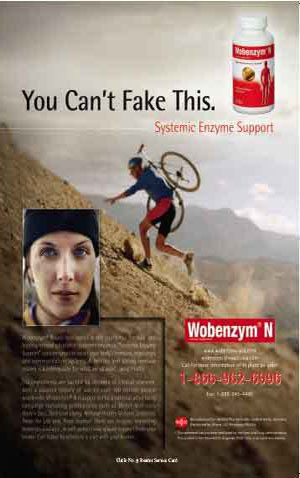 of cats by age three.” Pets who are gently introduced to tooth brushing at an early age will adjust to the process much easier, she adds, and recommends dental wipes that help control plaque when rubbed against pets’ teeth and gums twice a day for pets who completely refuse to allow brushing.
of cats by age three.” Pets who are gently introduced to tooth brushing at an early age will adjust to the process much easier, she adds, and recommends dental wipes that help control plaque when rubbed against pets’ teeth and gums twice a day for pets who completely refuse to allow brushing.
If even wipes are a lost cause, Hofve recommends taking pets to get regular cleanings by a veterinarian.
Also, according to Terry, “Raw vegetables high in cellulose help clean teeth naturally, so it would be good to experiment with different types to find ones your pet likes.” Pet owners, however, should not believe the myth that dry food will properly clean pets’ teeth as it will usually crumble before providing any helpful abrasive action.
The Cat’s Meow. Conventional cat litter is made from numerous ingredients that may cause more harm than good. Hofve advises that bentonite clay litter (clumping) can be problematic because cats and people can breathe in the dust that rises from cats’ natural digging behavior; the dust can stick to cats’ fur and paws and thus cause intestinal problems after they clean themselves; and clay litter is mined, non-renewable and fills up landfills every year with eight billion pounds of litter.
Natural pelleted litters made from sawdust, pine shavings and alfalfa are available. Pine-based products must be kiln-dried to remove harmful aromatic compounds, Hofve stresses. Natural litters, baking soda and a diligent owner can keep litter box odor under control. Also, other natural products like Kitty Litter Treatment from Earth Friendly Products can extend the life of litter and enhance its odor-absorbing qualities.
Happy Tails to You
There is one thing that will remain timeless—some good tail wagging. But just like humans, animals can have a wide range of emotions and behaviors including fear and aggression. Animals can be frightened by many things: storms, car rides, strangers, vets and groomers, or just being left alone. Emotional problems can manifest in various ways as pets try to tell their owners what’s wrong. Dogs may chew household items, repeatedly rub or bite a certain part of their bodies or become very territorial about their space. Cats may refuse to use the litter box and “go” on household items instead, or they may hide and rarely make themselves known.
In addition to these upsets, skin issues can also surface when a pet feels a great amount of stress or anxiety. To help ease pets’ anxiety, there are supplements available that include ingredients like omega-3s, B-vitamins, chamomile and valerian. These ingredients have also been shown to help pets experiencing aggression and anger (2).
Many pet owners also report that their pets have diminished energy levels. Kathy Santo, in her book, Dog Sense, explains how dogs who received nutritional counseling and supplementation had much improved energy levels, and emphasizes how increased exercise and activity levels do the same. Some dogs, however, might have a condition such as a thyroid problem or arthritis that can result in decreased energy and possibly weight gain. Pet owners should always consult a veterinarian to diagnose any conditions and before starting any new nutrition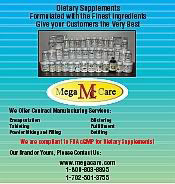 al or supplemental regimen for their pets.
al or supplemental regimen for their pets.
Dogs facing obedience problems should also consult a veterinarian or an experienced trainer who is accepting of holistic practices. These dogs might actually be “misunderstood,” and owners should examine their dog’s emotional makeup and personality to correctly fix the problem (3).
Overall, when pets feel physically well they will be less prone to emotional and behavioral problems. Says Spector, “The combination of natural food, essential supplements and chemical-free grooming products with daily brushing will help your pet be beautiful inside and out.” WF
References
- 1. Pet Food in the U.S.: Health, Humanization and High Quality Ingredients in an Increasingly Value-Driven Global Market, 8th Edition. Packaged Facts. January 1, 2009, Rockville, MD.
- 2. S. Holt and T.V. Taylor, Nature’s Benefit for Pets (Wellness Publishing, Fairfield, NJ, 2001).
- 3. K. Santo, Dog Sense (Alfred A. Knopf, New York, NY, 2007).
Published in WholeFoods Magazine, March 2009

